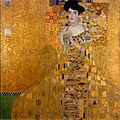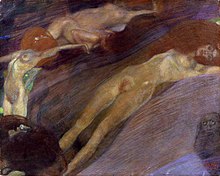Water snakes I.

|
| Water snakes I (girlfriends I) |
|---|
| Gustav Klimt , 1904/1907 |
| Mixed media with gold plating on parchment |
| 50 × 20 cm |
| Austrian Gallery Belvedere |
Water snakes I , also known as Freundinnen I , Parchament or Sisters, is a painting by the Austrian painter Gustav Klimt . It was painted between 1904 and 1907 in a mixed technique with gold plating on parchment , typical of the artist's golden period . Today the picture, which is only 50 × 20 cm in size, hangs like many other works by Klimt in the Austrian Belvedere Gallery .
Image description
The portrait format picture Wasserschlangen I shows two naked women in front of a background made of ornaments. The two women embrace, one being depicted as a nude from the back , the other from the front. The woman in frontal representation lays her head with her left side on the head of the other woman, her long blond hair surrounding her. The eyes are closed, the mouth slightly open. The left arm of this woman lies over the shoulder of the second woman and hugs her, the little finger is spread apart. The right arm is stretched out and angled at an angle of about 90 ° in both the crook of the arm and at the wrist, so that a trapezoidal surface is created between the arm and the side of the body . The right breast can be seen, the left half of the body is covered by the woman in the back view. From about the waist down, both bodies are only indicated. Accordingly, only the upper back of the second woman and her long, blonde hair can be seen.
The background is represented by ornaments arranged in several irregular and abstract surfaces, which are mainly in the colors gold, brown and light brown. The lower areas of the women's bodies also end in corresponding ornamental representations.
Through various figurative elements it can be seen that this image is an underwater scene. In the lower right-hand corner, for example, the head of a fish in shades of brown that cannot be identified in more detail is shown. It has a clearly toothed mouth and a dark, blind-looking eye. Above the fish rises a tentacle of an octopus , which first grows up parallel to the female body and then forms a spiral; another tentacle spiral is at the top of the picture. On the left half of the picture, some leafy tendrils in gold color, recognizable as aquatic plants, grow on a dark background. Similar plants, this time in green on a light background, entwine in the picture from above and also cover parts of the female body.
The parchment is framed in a dark frame decorated with embossed silver fittings, which was designed by Klimt himself.
Technology and style

Like many well-known paintings by the artist, the water snakes I come from its golden phase . Gustav Klimt saw the church mosaics, which were conspicuously decorated with gold, during a trip to Ravenna and Venice in 1903 and was subsequently inspired by these images of saints and rulers. He began to translate this visual language into a contemporary form and experimented with various techniques to redesign the surfaces of his works. In addition to oil painting , he used pastiglia , a type of relief technique, and gilding .
In the case of the water snakes I , mainly thick and pasty as well as glazed, translucent brushstrokes came into play alongside pencil and of course the gold and silver glossy surfaces typical of the phase. The contrast between the different color elements also comes into its own through the use of the semi-translucent parchment as a support surface. The background characteristic of Klimt is formed by ornamentally filled surface and form elements. In addition to Byzantine art , he was also inspired by Minoan , Mycenaean , Egyptian and medieval religious painting in Italy. In addition, his formal language shows the influences of the Japanese printing art Ukiyo-e , which was fashionable in Europe at the time, and the painting of the Edo period (see Japonism ). The female bodies in the foreground, and especially the faces and hair, are clearly recognizable, although not as realistically depicted as in portraits from the same period, such as the picture Adele Bloch-Bauer I (1907).
Other well-known works of this period are the Stoclet Frieze (1904–1910), The Three Ages of Woman (1905) and The Kiss (1907–1908). During these years women were the central main motif in Klimt's oeuvre.
interpretation
The closed eyes and the slightly open mouth of the woman, who turns her face towards the viewer, does not represent a sleeping, but rather a enjoying face according to common interpretation. It is viewed as a sign of sexual satisfaction and excitement, as is the splayed finger of the hand stroking her partner's hair and shoulder.
Origin and classification in the overall work
In Gustav Klimt's work, the subject of women floating and drifting in water is a regular feature, and in his landscape paintings, especially the later paintings of the Attersee , the subject of water itself, with its reflective surface and unfathomable depth, often plays a role.
The earliest work on which he takes up the motif of women floating in the water was the picture of fish blood drawn in 1898 , which he created for the magazine of the Vienna Secession Ver Sacrum . In the same year the oil painting Moving Water was created with the same main motif. As in Water Snakes I, the large fish with the empty-looking eye also appears in these pictures and clearly shows that it is a scene under water. In both cases the water symbolizes life and constant change. More images of this style are the two 1899 painted pictures Nuda Veritas and The sirens or silverfish that goldfish from 1901/1902 and of course parallel to the water snakes I resulting water snakes II . In these images, in particular in the two water snakes motifs stands an erotic component in the foreground, which is reinforced by the water and carried into the mysterious.
Before Klimt painted the water snakes, he made a series of drawings depicting naked women individually or in pairs. He experimented with the positions of the people in relation to one another and the postures of the individual women until he decided on two different compositions. On the one hand, it was a profile representation in which the two women were recognizable from the side and looked at each other, and a frontal representation in which the viewer could look directly into the face of one of the depicted. He decided on the latter variant, but used the former again and again in many other sketches. In Ver Sacrum , a first study for Water Snakes I appeared in 1903 , which was already very close to the later composition, but at the same time Klimt was also working on Water Snakes II , the first version of which on March 28, 1904 at the 20th Secession Exhibition were seen.
Relationship with works by other artists
The water snakes, together with the other water-moving paintings by Klimt, are compared by various critics with a wide variety of pictures by other artists and put in context. Alice Strobl, for example, emphasizes Klimt's Water Snakes I as the most important of the whole series of mermaid and undine pictures of his time and compares it with works by Arnold Böcklin , Edward Burne-Jones , Ludwig von Hofmann , Hans Christiansen , Heinrich Vogeler and Bruno Paul .
Neda Bei sees through the octopus tentacles, which associate sucking and grasping and thus strengthen the erotic component of the picture, primarily a borrowing from the erotic woodcut The Dream of the Fisherman's Wife by the Japanese artist Hokusai .
According to Novotny / Dobai, there is a relationship with Franz von Stuck's Sünde and works by Carl Strathmann , such as Salambo , and Egon Schiele's water spirits are definitely influenced by the driving bodies of Klimt, who is considered Schiele's teacher and patron.
Provenance
The first exhibition of the work took place in 1907 in the Miethke Gallery in Vienna, which also owned the picture and offered it for a price of 5,000 guilders at the time. In 1908 it was shown at the Vienna Art Show and in 1911 at the International Art Exhibition in Rome, in the Austrian Pavilion. From Galerie Miethke, the picture first became the property of the Karl Wittgenstein Collection and subsequently to Galerie Neumann. In 1950 it was acquired for the Österreichische Galerie Belvedere and appeared there in 1959 in the exhibition of the gallery's new acquisitions. It is still owned by the Austrian Gallery and has been shown several times in Klimt exhibitions. Due to the heavily corrugated parchment, the picture had to be restored in 1973; this work was taken over by Otto Wächter at the gallery.
Literature and further information
Remarks
Most of the information in this article is taken from the works listed under literature; the following sources are also cited:
literature
- Fritz Novotny, Johannes Dobai: Gustav Klimt: Catalog raisonné d. Painting. Verlag Galerie Welz, Salzburg 1975 (2nd edition, official catalog raisonné of Klimt's paintings)
- Tobias Natter, Gerhard Frodl (Ed.): Klimt and the women. DuMont Verlag, Cologne 2000; Pages 235–240 (exhibition catalog for the Millennium Exhibition Klimt and the Women in the Austrian Gallery Belvedere, September 20 to January 7, 2000)
- Alice Strobl: Gustav Klimt. The drawings 1904–1912. Verlag Galerie Welz, Salzburg 1982; Pages 58–88 (official catalog raisonné of Klimt's drawings, second volume)









